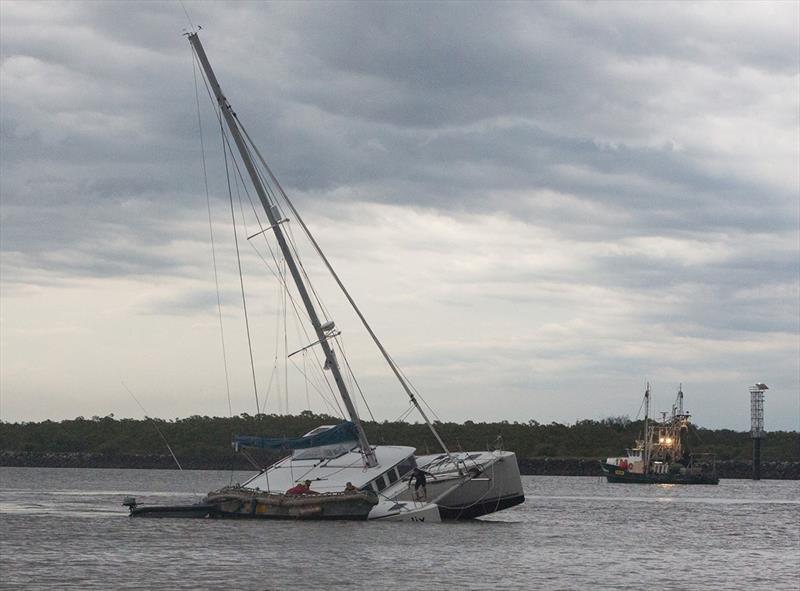
Our boat sank! What did we learn?
by Helen and Ben 7 Mar 2018 13:52 UTC

Lagoon 400 catamaran Felix sank in the Burnett river © Helen and Ben
Many readers know that our much loved Lagoon 400 catamaran Felix sank in the Burnett river (Bundaberg Port Marina) in early November 2017 after completing the Doyle Pacific Circuit Rally with Island Cruising. We sailed Felix from Noumea to Bundaberg with the GO WEST component of the Down Under Rally. Most cruisers would think that they would be safe tied up to a Marina berth, but a sudden short lived intense storm with winds of up to 70 knots decided otherwise. Four 14 mm mooring lines were snapped just like that.
Now that we've had 3 months to deal with the aftermath and settle down, it has been a useful exercise for us to ask ourselves what the experience reinforced for us, and what we might have done differently.
One of the key things, of course, is to make sure that you are insured for an adequate amount and with a reputable insurance company. Insurance was a key topic of discussion with other cruisers after the event, and it surprised us how many cruisers carried only third party insurance or in a few cases had no insurance at all. Whilst some people may have money to burn, with-out our insurance we would now not be looking for another boat and now looking forward to more cruising adventures. An insurance broker can be helpful in identifying a reputable insurance company and ensuring that the policy covers such important items as salvage and personal items.
Whilst in New Zealand our Coastguard is ready to assist 24/7, our channel 16 call to the Australian equivalent asking for assistance did not result in any useful help. Our call was made at about 5:45 pm and we were told that the station was closing down at 6:00 pm, and that because they were volunteers it would take at least half an hour to get a crew together, and that they would need to re-move some timber off the launching ramp first. As our boat was sinking fast, we decided that we would need to rely on help from people at the marina. Whilst some cruisers had turned off their VHF radios on tying up at the marina, a Pan Pan call immediately bought out lots of help.
An EPIRB is a wonderful piece of safety equipment. Our EPIRB went off as soon as it got wet, and as we learned later, within 5 minutes the Rescue Coordination Centre NZ had phoned AMSA (their Australian counterpart) to advise them that our EPIRB had been activated. The leader of the Go West Rally had the presence of mind to phone AMSA and explain that help was at hand, and that we did not need the Australian Marine Rescue Services to come looking for us.
When it was obvious that we would have to leave our boat, we were grateful for the practical Survival at Sea course we had done prior to leaving New Zealand – we were able to act calmly, knowing what was important without having to look for new solutions to our problems. Because we had only arrived in Bundaberg a few days previously, our dinghy was still securely tied down for the ocean passage. Our dinghy was our means of stepping off our sinking boat, and we were very pleased to have sharp knife readily at hand to cut the dinghy down. Also our grab bag and life jackets were still close at hand, and not yet stowed away as we would usually do when staying in a marina. Perhaps keeping these items close at hand at all times would be a more sensible thing for us to do. Our biggest loss was the photos and personal documents we kept on our computer. Although we had a back-up drive and regularly backed up our data, both the laptop and back-up drive went down with the boat. Next time we will definitely be using some sort of off-site back-up system.
Probably one of the most important things we learnt was that despite general opinion to the contrary, when one hull of a catamarans is holed, the other hull does not necessarily keep the vessel afloat. This raises the question for us, when a catamaran is upside down, is it sensible to cut a hole in the hull to gain access to supplies etc, or would letting the air out cause the vessel to sink? Cat 1 Regulation require cruisers to carry some means of cutting a hole in the hull, supporting the idea that it is OK to do so, but perhaps not?
Our experience left us with a great sense of gratitude for being part of a wonderful supportive cruising community. It reinforced the value of being part of a Rally too – while the greater yachting community was amazing, it was our fellow Down Under - Go West and Island Cruising Rally participants who gave us immediate and ongoing care and support.
We felt both humbled and blessed.
This article has been provided by the courtesy of the Island Cruising NZ.